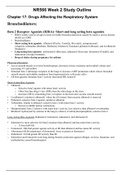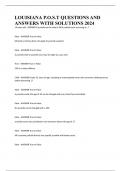NR566 Week 2 Study Outline
Chapter 17: Drugs Affecting the Respiratory System
Bronchodilators:
Beta 2 Receptor Agonists (B2RA): Short and long acting beta agonists
• B2RA widely used in all ages to treat reversible bronchoconstriction caused by reactive airway disease
(RAD) or COPD
• Bronchodilators
• Short-acting beta agonists: Albuterol (ProAir, Ventolin, Proventil) , metaproterenol
(Alupent), terbutaline (Brethine, Brethaire), bitolterol (Tornalate), pirbuterol (Maxair), and levalbuterol
(Xopenex)
• Long-acting beta agonists: arformoterol (Brovana), salmeterol (Serevent), formoterol (Foradil), and
indacaterol (Arcapta Neohaler)
• Drug of choice during pregnancy for asthma
Pharmacodynamics
• Act on smooth muscle to reverse bronchospasm, decreases airway resistance and residual volume and
increasing VC and airflow
• Stimulate beta 2 adrenergic receptors in the lungs to increase cAMP production which relaxes bronchial
smooth muscle and inhibits mediators from hypersensitivity cells (mast cells)
• All beta agonists stimulate beta 1 activity (increased HR, tremor)f
Short Acting Beta Agonists
• Albuterol
o Selective beta2 agonist with minor beta1 activity
o Often first-line drug r/t less ADRs than the other drugs in this class
o Increases HR by stimulating beta 2 receptors in the heart and vascular smooth muscle
• Levalbuterol: (similar to albuterol), where the (S)-isomer from racemic albuterol is removed
• Pirbuterol: selective beta 2 agonist, similar to albuterol
• Terbutaline: similar to albuterol, selective beta 2 with minor beta 1 activity
o Known to inhibit uterine contractions
• Metaproterenol: beta 2 selective with some beta 1 activity, less selective than albuterol or terbutaline
• Bitolterol: hydrolyzed by esterase in the lung to colterol, or terbutylnorepinephrine, selective beta 2
Long Acting Beta Agonists (Salmeterol, formoterol, indacaterol, and aformoterol)
• Salmeterol is more selective for beta2 receptors than albuterol and has minor beta1 activity.
o 12 hour half-life
o Formoterol: 200-fold greater agonist activity at B2 than albuterol and has minor B1 activity
o Aformoterol (R,R)-enantiomer of formoterol, twice as potent as formoterol
o Indacaterol: 24 fold greater B2 activity than B1
o Salmeterol and formoterol exert long-lasting broncho protection against allergen, exercise, histamine, and
methacholine caused bronchospasm
,Pharmacokinetics
• Contraindications: Cardiac arrhythmias (tachycardia or heart block caused by digitalis intoxication,
angina, narrow-angle glaucoma, organic brain damage (epi only), and shock during general anesthesia with
halogenated agents
• Monitor closely: HTN, ischemic heart disease, coronary insufficiency, CGH, and Hx of stroke and/or
cardiac arrhythmias
• Diabetics: potential drug-induced hyperglycemia, insulin dose may need increased
• Hyperthyroidism: ADRs are more likely to occur with use of bronchodilators
• Digoxin: require close monitoring, albuterol increases the volume of distribution of dig and can cause
decreased dig blood levels
• Pheochromocytoma: avoid, severe HTN may occur
• Older adults: Lower doses r/t increased sympathomimetic sensitivity
• Black Box warning for LABAs: The risks of salmeterol (Serevent) and formoterol (Foradil) outweighed
the benefits and should not be used singly in asthma for all ages
o Two-fold increase in catastrophic events (asthma-related intubations and death)
o The use of LABAs is contraindicated without the use of an asthma controller medication such as an
inhaled corticosteroid
o Only use long-term in patients who asthma cannot be adequately controlled on asthma controller
medications
o Use for the shortest duration of time required to achieve control, then maintain on an asthma
controller medication
o Pediatric and adolescent patient who require addition of a LABA to an inhaled corticosteroid should
be a combination product containing both an inhaled ICS and a LABA, to ensure compliance with
both medications
• Terbutaline pregnancy category B (prevent contractions) (others category C)
• Albuterol safe for all age children
• Metaproterenol can be used in young children
• Levalbuterol, as young as 2 (drug insert says 6)
• Salmeterol should not be used in children less than age 4 years and never singly.
• Formoterol age 5 and older
• Indacaterol and aformoterol are used for COPD, not for use in children or adolescents
Drug and Food Interactions
o Many drug interactions
o Digitalis glycosides: increased risk of dysrhythmia
o Beta adrenergic blocking agents (Beta Blockers): direct competition for beta sites resulting in mutual
inhibition of therapeutic effects
o Including beta blocker eye drops
o Tricyclic antidepressants and MAOIs potentiate effects of beta agonist on vascular system
ADRs
o Usually transient
o Stopping the med is not usually needed, reduce dose then slowly increase
o Supraventricular and ventricular ectopic beats have occurred
o Tachycardia and palpitations
o Some central nervous system (CNS) excitation effects
o Tremors, dizziness, shakiness, nervousness, and restlessness
o Headaches, rarely insomnia, post inhalation cough
o Salmeterol has an increased risk of exacerbation of severe asthma symptoms if the patient is
deteriorating
o Overuse can lead to seizures, hypokalemia, anginal pain and HTN
, o Stimulant like effects
o GI upset, take po meds with food
Clinical Use and Dosing
Bronchospasm
• Bronchodilators are used primarily in the treatment of bronchospasm associated with asthma, bronchitis
(acute or chronic), and chronic obstructive pulmonary disease (COPD)
o Albuterol
MDI dose children over 4 and adults is 2 puffs every 4 to 6 hours
o Nebulizer dose children over age 12 and adults is 2.5 mg/dose
For younger children over 15 kg, dose is 0.1 to 0.15 mg/kg/dose
o Dose may be repeated once after 5 to 10 minutes, up to 2 times, three doses total during
exacerbations
o Oral dose in adults is 2 to 4 mg 3 or 4 times a day
For children 6 to 12, 2 mg albuterol 3 to 4 times a day (PO form rarely used in
children)
Oral syrup: children under age 6, 0.1 mg/kg 3 times a day (rarely used)
o May combine with ipratropium
o Aformoterol (Brovana): nebulizer 15 mcg/ by inhalation BID (not approved for use in children)
o Indacaterol (Arcapta Neohaler): powder via a Neohaler device
adults with COPD, one capsule one daily with a Neohaler device
o Levalbuterol (Xopenex): inhalation solution (nebulizer) in adolescents over age 12 and adults is 0.63
mg TID (every 6 to 8 hours)
Children: 6 to 11: 0.31 mg TID, do not exceed 0.63 mg TID
Children 4 and younger: 0.31 to 1.25 mg every 4 to 6 hours
Inhaler: one to two puffs repeated every 4 to 6 hours
o Metaproterenol (Alupent): MDI, inhalation solution, and syrup forms
o Terbutaline: MDI (Brethaire), PO tablets (Brethine), or parenteral form for SC injection
o Pirbuterol: only available as MDI (Maxair Autohaler)
o Bitolterol (Tornalate): MDI: acute bronchospasm two puffs 1 to 3 minutes apart
o Salmeterol (Serevent DISKUS): 1 puff BID
o Do not use alone for persistent asthma, combine with an inhaled corticosteroid
o Packaged with Fluticasone (Advair DISKUS) differing doses
o Formoterol: 12 mcg, single use dry powder capsule
o Ipratropium: inhaled anticholinergic, may be used in combination with albuterol to treat asthma
exacerbation in the ER
Bronchodilator of choice3 in patients taking beta blockers or who do not tolerate beta 2
agonists
Exercise-induced bronchospasm (EIB)
o Albuterol or other SABA and salmeterol
o Albuterol MDI: 2 puffs 15 minutes before exercise, lasts 2-3 hours
o Salmeterol: 2 puffs 30 to 60 minutes before exercise, duration 10 to 12 hours
o Cromolyn or nedocromil may be used before exercise, not as effective
o Leukotriene modifiers taken daily may decrease EIB symptoms in 50% of patients, but patient
will still need to use albuterol before exercise
Xanthine derivatives
o Methylxanthines have declined in importance in the Tx of asthma, but some patients may still benefit from
the use of theophylline
o Theophylline and Caffeine
, o Bronchodilator
Pharmacodynamics
o Bronchial smooth muscle relaxation
o CNS stimulants
o CV effects
o Increased gastric acid production
o Stimulate skeletal muscle
o Increased renal blood flow and GFR
o Work directly by an unknown mechanism: mediated by selective inhibition of specific phosphodiesterase
o Increased production of cAMP=bronchial smooth muscle and pulmonary vessel
relaxation
o Theophylline and caffeine: powerful CNS stimulants (insomnia and excitability)
o Theophylline has a greater effect on the cardiovascular system
o Theophylline directly stimulates the myocardium and increases myocardial contractility and HR
o Relaxes vascular smooth muscle, dilates the coronary, pulmonary, and systemic blood vessels
o Both theophylline and caffeine: increase gastric acid production (may cause NV)
o Stimulate skeletal muscle: tremors
o Theophylline: Acts directly on the renal tubules to cause increased sodium and chloride excretion
o Both cause diuresis r/t action on the kidneys (increased blood flow to kidneys)
Pharmacotherapeutics
o Contraindications to theophylline: hypersensitivity to xanthine, PUD, and underlying seizure disorder
o Contraindications to caffeine: hypersensitivity to caffeine or use of caffeine sodium benzoate formulation
in neonates
o Use Caution: HTN, ischemic heart disease, coronary insufficiency, CHF, or Hx of stroke and cardiac
arrhythmias r/t effects on CV system
o Toxicity: levels above 25 mcg/mL
May occur if clearance is decreased (hepatic impairment, chronic lung disease, cardiac failure,
patients older than 55, and infants under 1)
o Theophylline: Pregnancy Category C, crosses placenta, newborns may have therapeutic serum levels if
maternal levels are high-normal range (tachycardia, irritability, and vomiting)
o May be used in children: infants younger than 1 have decreased theophylline clearance and closely monitor
levels should be a range of 5 to 10 mcg/mL
o Caffeine citrate is used to treat apnea of prematurity
o Pregnancy Category C
Theophylline: Drug and Food Interactions
o Many drug interactions due to metabolism via CYP 450 isoenzyme CYP1A2, CYP2E1, and CYP 3A3/4
o Increase serum theophylline: allopurinol, VVs, CCBs, cimetidine, cipro, oral contraceptives,
corticosteroids, disulfiram, ephedrine, flu vaccine, interferon, macrolides, quinolones, THs,
carbamazepine, IZD, loop diuretics
o Decrease serum theophylline: aminoglutethimide, barbiturates, charcoal, hydantoins, ketoconazole,
rifampin, smoking, sulfinpyrazone, beta agonists, carbamazepine, isoniazid, loop diuretics, lansoprazole,
primidone, ritonavir
o Lithium: theophylline may increase renal clearance of lithium=reduced levels
o Smoking tobacco increases theophylline clearance (may take months to 2 years to normalize theophylline
clearance after quitting)
o Benzodiazepines are antagonized by theophylline






